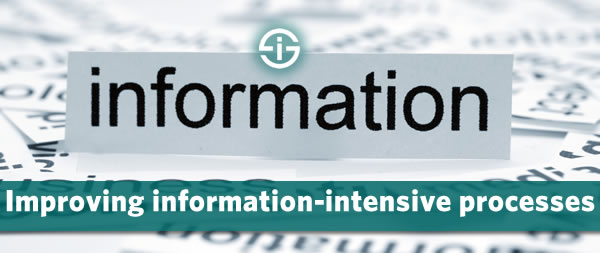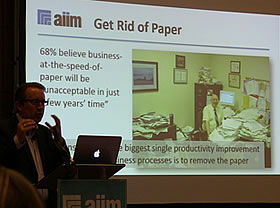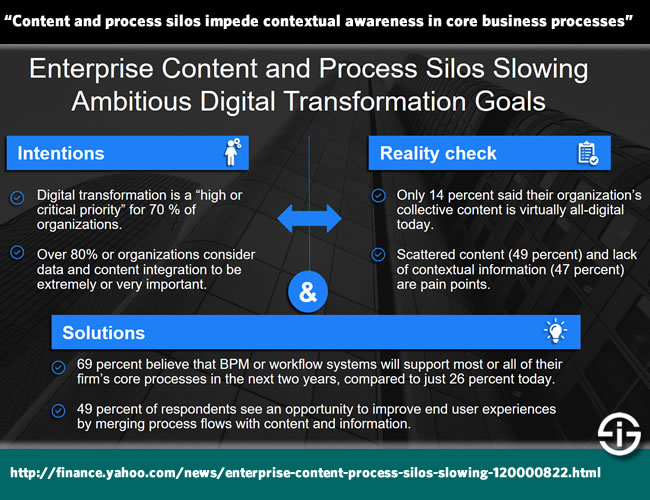Information-intensive processes are becoming more important and more numerous. How else could it be in the next stage of the information age where data and information have become core business assets?
Moreover, we’re at the verge of an explosion of even more possibilities regarding the sources, types, use cases and benefits of data, information and insights, thanks to the Internet of Things. If you thought that we are at the peak of the information age, think again. Software is eating the world but it mainly does because data and information are eating the world.
The good old information management mantra of getting the right information at the right place and time and so on, is about to becoming meaningless. Or better: the question will not be how to achieve that “right everything” goal but what are you going to do next? Because all companies that want to succeed in the next information age stage will need to have the capabilities to provide the right information at the right time across the right processes and applications for the right reasons to the right outcomes, people, places, etc.

Information excellence as a basic business capability
Compare it with customer service and even customer experience. Improving service and ‘offering’ or ‘enabling’ better customer experience across the board might – and will – be a challenge for several years to come but customers start taking it for granted.
It’s almost a ‘basic expectation’ and seen as an essential business service capability. By the way: customer service and customer experience optimization these days also increasingly revolve around very information-intensive processes and connected information sources, away from the systems of record silos.
Information management excellence, which by definition is a holistic and integrated given and assumes that we get the “right this and that” conditions in order is also becoming an expected basic business capability.
We know that achieving information management excellence by far isn’t a fact yet of course and that it’s easier said than done but those companies who are able to master it, are also able to start tapping into the real data, information, knowledge and decision opportunities that are coming fast in the context of digital transformation, the Internet of Everything and, most of all, the possibilities to create information-intensive and information-based ecosystems of value creation, new business models and unseen new ways to leverage the power of data.
Everyone knows that the opportunities and initiatives to create new revenue streams and business models whereby data is monetized, are increasing. To put it into perspective, according to IDC’s Worldwide CIO Agenda 2017 predictions, by 2019, 40 percent of IT projects will create new digital services and revenue streams that monetize data. Again: 40 percent of IT projects, within about two years from now. That’s a lot.
Improving information-intensive processes in practice
Again, it’s easy to say that information management excellence becomes a ‘basic’ condition to reap the fruits of investments in innovations in the scope of digital transformation and the hyper-connected world of people, processes, things, data, meaning and outcomes. Just as it’s easy to say that excellent customer service should be a basic given.
In reality such journeys are never entirely finished and require ongoing commitment. We don’t want to offend all those people out there who are working hard to implement a more customer-centric culture or to review and dramatically improve the ways they are dealing with information; often even despite lacking management support and understanding.
While some are already far on the road towards information management excellence, for most organizations the questions remain a bit more down to earth: how can we improve our information-intensive processes and our information management skills in a broader sense and context than ever before?
And with that question comes a second one: how can technologies help me in achieving this? Keeping our ‘goals of excellence’ in mind, this improvement of information-intensive processes can mean many things, often even happening at the same time but fortunately also often connected.
Digitization: paper-based processes remain a challenge
On the most essential level there is the challenge of digitization.

How do I turn paper and slow paper-based processes into more efficient digitized processes with less room for errors and better overall efficiency, close to the process, the worker, the source and the outcome? It remains a challenge for many of us as paper-based processes continue to hinder goals of digitalization and transformation.
Security, governance, compliancy and privacy
Next come aspects such as security and governance.
How do I improve these aspects of my information-intensive processes to not just prevent security breaches and governance requirements but also to meet stringent regulatory requirements regarding data privacy and other factors that are coming from everywhere?
Rapid access to information to solve a case or enable the knowledge worker
Then there is the integration of information-intensive processes or the connection, in order to make sure that, regardless where various pieces of information ‘sit’, they can be used by knowledge workers who don’t have to go through dozens of systems or waste hours of time looking for information to work, serve customers, you name it.
This question alone has led to several industry changes and approaches, depending on the context. Think about adaptive case management, for instance. Or about the various ways to build bridges between information repositories, front end and back office, as we see it in customer-facing and transactional situations and also in the closer connection of LOB systems and capture processes. It’s also where there the need to merge content with process is clear.

Improved collaboration
Enhanced collaboration possibilities is another one.
Having secure access to digital information so you have the means to work on a case or to resolve a customer question, with all the information at your fingertips, is already a dream come true. But you also want to be able to collaborate in many circumstances. And you’ll have to in those ecosystems of value.
Making sense of data and information: the analytics priority
Last but not least, and this list is not exhaustive, comes the question of better making sense of all this data and information that comes from multiple sources, with a big growth in unstructured communications and content.
That’s where content analytics come in. Artificial intelligence and cognitive, if you will, which are de facto the only ways to derive meaning from big data and the loads of unstructured information we’re confronted with on a daily basis, certainly also in customer service. This is the big one virtually all organizations are looking at in this age of big data and unstructured data, certainly with current evolutions in mind.
According to a November 2016 press release from IDC, “organizations that capitalize and analyse all relevant data and deliver actionable information could achieve an extra $430 billion (on a worldwide basis) in productivity benefits over their less analytically oriented peers by 2020”.
The new information management reality: business drives decisions and investment
It’s clear that enterprise content management and, increasingly we speak about (enterprise) information management, is evolving and disrupted by several of the mentioned and other challenges.
In a world where the business takes many buying decisions regarding technologies and business drives the agenda, it’s obvious that the choice of the right solutions to enhance your information-intensive processes and to be able to move towards that next stage of digitalization and digital transformation, needs to be solved from the business side and business perspective.
That, as such, is already a challenge and change for many. And, let’s not forget that, although many business leaders understand the importance of information and data, and thus of information management excellence, their information management maturity perceptions aren’t exactly corresponding with reality as we’ve mentioned several times. Just one example: the gap between the perceived ability of organizations to unlock the value in their information on one hand and the reality on the other.
Top image: Shutterstock – Copyright: alexskopje – All other images are the property of their respective mentioned owners.

